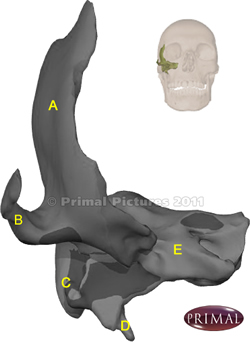The temporal bone is a complex bone composed of several regions. The image shows an anterior view of the right temporal bone. To see the location of the bone, look at the inset that shows by transparency the location of the bone. Click on the image for a larger picture.
A. Squamous portion: From the Latin [squama], and meaning "scale-like", this portion of the bone is very thin, articulating with the parietal and sphenoid bones.
B. Zygomatic process: an anterior extension that articulates with the corresponding temporal process of the zygomatic bone.
C. Mastoid process: A Greek term from [-mast-] meaning breast, and the suffix [-oid] meaning "similar to".
D. Styloid process: Another Greek term from [stylos] meaning a "pillar", but also a "pen", therefore "shaped or similar to a pen". This is a slender and long inferior bony process. Close to the syloid process there are other processes, the pterygoid processes.
E. Petrous process: From the Latin [petrus] meaning "rock". The petrous process contains the components of the external auditory canal, the middle and inner ear, and a large canal through which passes the internal carotid artery.

First image modified from the original: "3D Human Anatomy: Regional Edition DVD-ROM." Courtesy of Primal Pictures.
Animation via Wikimedia Commons, public domain. Polygon data generated by Database Center for Life Science (DBCLS), CC BY-SA 2.1 JP.




